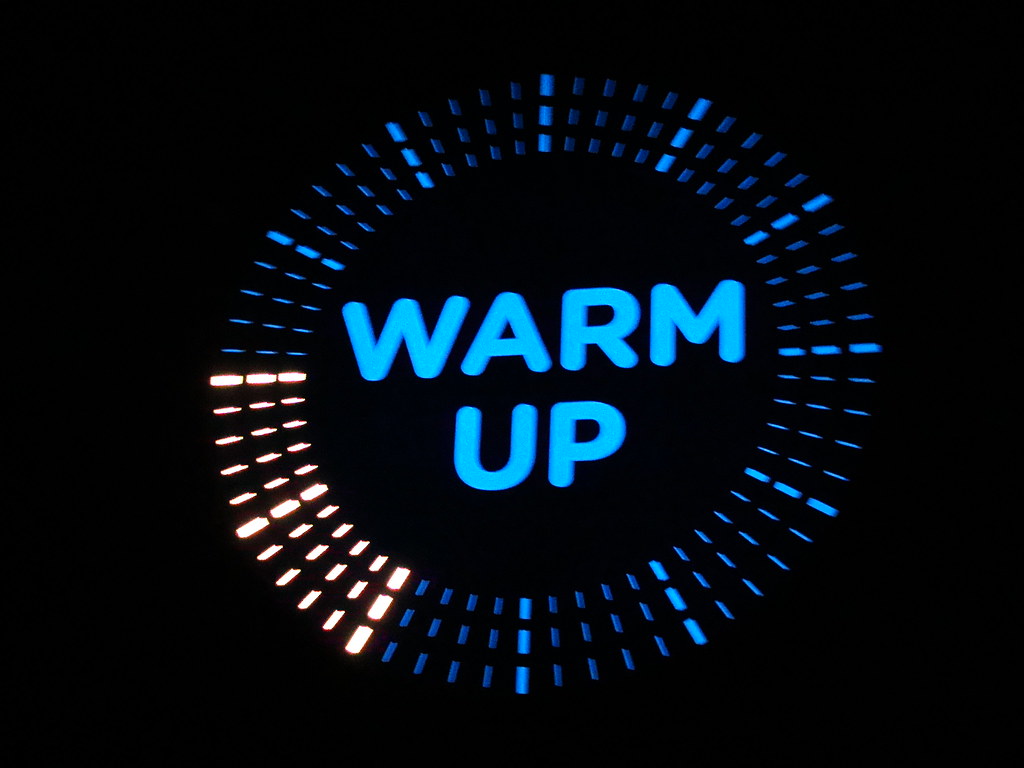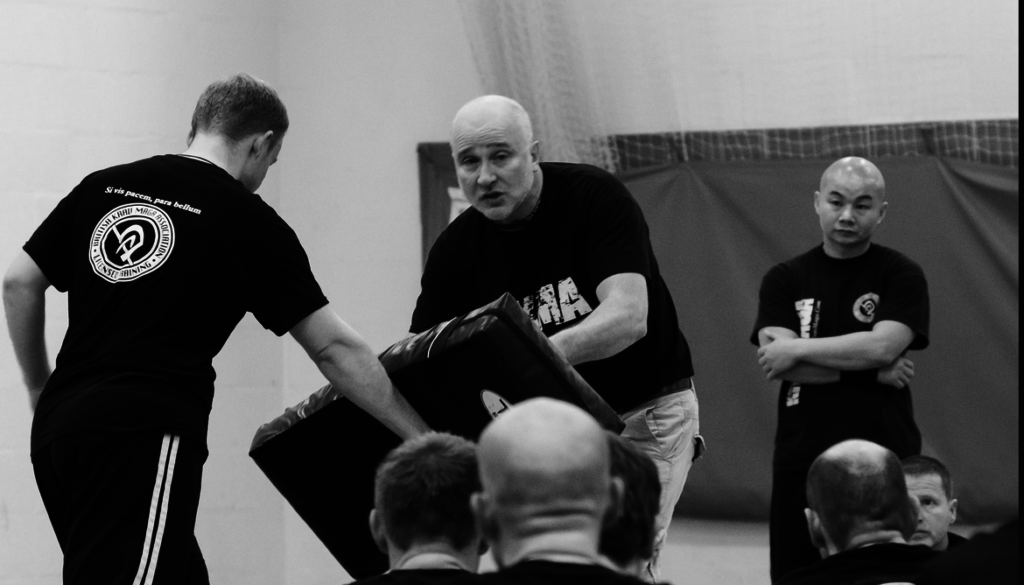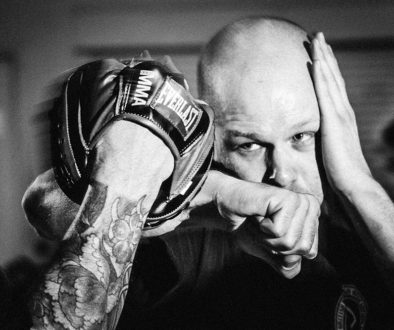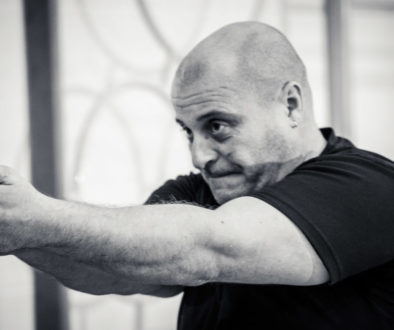Krav Maga Leeds – Warming up
 Leeds Krav Maga Instructor Mike writes about the process of warming up
Leeds Krav Maga Instructor Mike writes about the process of warming up
The warm up is probably the most neglected part of everyone’s workout. Most people mistakenly believe that 5 minutes on a piece of cardio equipment will fully prepare your body for the rigors of the work you are about to face. Whilst better than nothing, as it does raise your core temperature and get blood into a lot of your muscles, several areas are neglected by this approach, and Mike of Leeds Krav Maga explains why.
Mobility/Movement patterns: Try folding your arms, right now. Ok good. Now change which arm is on top and notice how confusing this is to try and do. The reason the first one felt so natural is that you’ve probably folded your arms several times a day since you were about 3 years old, you’ve literally practiced this movement everyday throughout your entire life. Your body and muscles remember these movement patterns and effectively “stores” them so that you can use them more readily. We refer to these patterns as Motor Engrams.
In order to build a Motor Engram it takes a lot of practice, it makes sense that we want to be good at whatever exercise we are taking part in yes? It is vital that during the warm up we are reproducing motor patterns that will happen during the training session – even more so with some of the explosive techniques that are involved in training at Krav Maga Leeds. Your joints also need to be warm to move better. When we perform these movement patterns your joint produce synovial fluid which aids movement. We also need to “tease” movement out of tight muscles with dynamic movements which help to release adhesions, encourage blood flow into the muscles and free up the joints a little more to allow movement to happen.
Muscle Tension: For various reasons your muscles will be tight before you begin exercise, this is typically due to adhesions (think if this as unwanted scar tissue that forms bonds between internal structures such as muscles and organs that shouldn’t be connected), or trigger points (Areas of muscle which are tight and sore to touch).
These areas of pain result in muscles being painful, tight and not contracting effectively, not only do these areas cause pain but they actually affect your ability to perform (a muscle which cannot contract properly is not performing to its full potential) and they increase your risk of injury during exercise. It’s important to work on these areas of tightness using Self Myofascial Release (SMR) with a foam roller or tennis ball to release these areas of tightness before exercise.
Activation: Imagine curling a dumbbell by flexing your Bicep, it shortens and pulls your arm up to flex it and lift the weight. To do the opposite movement and extend your arm it requires the Triceps to shorten and pull the arm back to straight. In order for both of these movements t occur, the non-moving muscle must relax and allow itself to be stretched otherwise both muscles would tense and very little movement would occur. This process is called ‘Reciprocal Inhibition’ and it happens everywhere in your body.
The problem is that in our modern lives we spend a lot of time seated or holding our body in odd positions, supported by chairs, or leaning against things. What happens when we do this is that certain muscles (think of hip flexors being activated whilst seated) are switched off all the time. It’s important to “wake up” these muscles before we exercise (particularly the Glutes as they are one of the main muscles to activate during movement in stance and various other techniques we use at Leeds Krav Maga) to ensure that we are using the right muscles when we train – this also falls loosely into the Movement Patterns section above i.e. we must train these muscles to work during the movement pattern we intend to use.
Mental: Ever really felt like you don’t want to do something? You try and do it anyway, so you hit it as hard as you can muster, get a few minutes in, want to leave, don’t put as much effort in then end up leaving anyway most times and if you do stay you don’t work particularly hard. The Mental aspect of training is extremely important.
If your head isn’t in it, your body won’t be either. What a good warm up does is it allows you to slowly get out of your head and into your body. As your get warm through basic movements, mobilisations, foam rolling and pulse raising, you start to slowly increase the levels of endorphin in your blood, you begin to feel good and like you want to exercise and move and by the time you’re finished you can’t wait to start. What’s great is that your body learns to experience this feeling over and over again and as soon as you start to warm up your body associates this with feeling good and you build a habit of feeling good about exercising!
Nervous system: The strength and power output of a muscle is largely determined by its cross-sectional area as well as the extent to which it is activated. It is well accepted that many of the adaptations to resistance training occur within the nervous system (Sale, 1988). Your muscles are made up of thousands and thousands of fibres. When these contract they cannot partially contract they can only fully contract.
This causes problems as we want to exhibit control of our muscles when we need to move things gently, so it would be very problematic if every time you contracted your bicep, it contracted as hard and fast as it possibly could and instead of gently lifting your bag, you forcefully smashed yourself in the mouth with it.. Your body gets around this problem by having “Motor Units”. This is a bundle of muscle fibres controlled by a nerve, meaning when it is activated, only those fibres fully contract, not the entire muscle.
What this means is that in order to generate ballistic force (such as in a Kick, Knee strike or Punch), more motor units must fire at once to generate maximum force. Otherwise we don’t generate enough force and an incorrect movement pattern is the result (which could cause injury). We must “excite” the nervous system before we exercise to ensure it is ready to generate output and thus force.
As you can see, an ideal warm up covers more than just a few minutes on a piece of Cardio kit and is actually vital to ensure our chances of our best performance are high and the chances of injury are low. This is the ideal structure for a warm up:
 Self-Myofascial Release / Foam Rolling: Before we do any kind of exercise, including mobility, we want rid of anything causing tension or tightness.
Self-Myofascial Release / Foam Rolling: Before we do any kind of exercise, including mobility, we want rid of anything causing tension or tightness.
Mobility: Now that we have gotten rid of anything causing tightness we want to prepare our joints to be used by working them through a full range of motion and accessing the mobility that we have freed up using the SMR and Foam rolling techniques.
Activation: Before we start properly exercising we need to make sure that we are fully recruiting all muscles that will be involved, we obviously cannot take this step until we have freed up maximum available movement and mobility (what is the point of activating a muscle if we can only move it half as far as it goes?)
Pulse raiser / Nervous system excitation: Now that we have freed up movement, mobilised and activated all muscles that will be involved in the movements, we can begin to raise the pulse and excite the nervous system by using full body plyometrics exercises and dynamic movement patterns such as lunges, squats, press ups, box jumps, star jumps etc to raise the core temperature and pulse rate, excite their nervous system and gear up the heart and lungs to work out.
Here is my Sample warm up for a Leeds Krav Maga session:
Foam Rolling: Ilio-tibial Band, Quads, Piriformis, Upper Back
Mobility: Shoulder dislocation stretch, Thoracic spine mobilisation, hip flexor mobilisation, rocking ankle mobilisation
Activation: 10 x Scapular Pull ups, 10 x Scapular Press Ups, 10 x Glute Bridges, 10 x Bird dog (To activate core)
Pulse raiser / Nervous system excitation: Jogging around the room, performing exercises such as press ups, jumping, lunging, sit ups, throwing punches etc.
There you have it, a perfect template for a warm up as well as justification surrounding why you should never neglect your warm-up!
Enjoy
Mike




